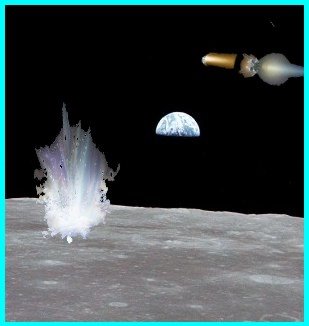
Science@NASA
4-10-06
April 10, 2006: NASA today announced that a small spacecraft, to be developed by a team at NASA Ames, has been selected to travel to the moon to look for precious water ice at the lunar south pole.4-10-06
The name of the mission is LCROSS, short for Lunar CRater Observation and Sensing Satellite. LCROSS is a secondary payload: It will hitch a ride to the moon onboard the same rocket as the Lunar Reconnaissance Orbiter (LRO) satellite due to launch from the Kennedy Space Center in October 2008.
"The LCROSS mission gives the agency an excellent opportunity to answer the question about water ice on the moon," says Daniel Andrews of NASA Ames, whose team proposed LCROSS. "We think we have assembled a very creative, highly innovative mission."
LCROSS will hunt for water by hitting the moon--twice--throwing up plumes that may contain signs of H2O. It works like this:
After launch, the LCROSS spacecraft will arrive in the moon's vicinity independent of Lunar Reconnaissance Orbiter. On the way to the moon, the LCROSS spacecraft's two main parts, the Shepherding Spacecraft (S-S/C) and the Earth Departure Upper Stage (EDUS), will remain coupled. As the pair approach the moon's south pole, the upper stage will separate, and then hit a crater in the south pole area. A plume from the upper stage crash will develop as the Shepherding Spacecraft heads in toward the moon. The Shepherding Spacecraft will fly through the plume using its instruments to analyze the cloud for signs of water and other compounds. Additional space and Earth-based instruments also will study the 2.2-million-pound (1000-metric-ton) plume.
"This type of payload is not new to NASA," says Associate Administrator for the Exploration Systems Mission Directorate Scott Horowitz, who made the selection. "We are taking advantage of the payload capability of the launch vehicle to conduct additional high risk/high payoff science to meet Vision for Space Exploration goals."
Lunar Reconnaissance Orbiter and LCROSS are the first of many robotic missions NASA will conduct between 2008 and 2016 to study, map, and learn about the lunar surface to prepare for the return of astronauts to the moon. These early missions will help determine lunar landing sites and whether resources, such as oxygen, hydrogen, and metals, are available for use in NASA's long-term lunar exploration objectives.
More . . .
See Also: Spacecraft to Slam into the Moon
No comments :
Post a Comment
Dear Reader/Contributor,
Your input is greatly appreciated, and coveted; however, blatant mis-use of this site's bandwidth will not be tolerated (e.g., SPAM, non-related links, etc).
Additionally, healthy debate is invited; however, ad hominem and or vitriolic attacks will not be published, nor will "anonymous" criticisms. Please keep your arguments/comments to the issues and subject matter of this article and present them with civility and proper decorum. -FW